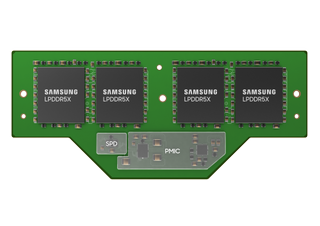Samsung today announced that it has developed a Low Power Compression Attached Memory Module (LPCAMM) lineup that leverages LPDDR5X memory in a smaller, faster, and more efficient package than standard memory. Samsung says the new LPDDR5X-6400 modules deliver up to 7.5 gigabits-per-second of memory throughput and consume 60% less board space while delivering 50% more performance than current SO-DIMM memory modules. The dual-channel Samsung LPCAMMs come in 32, 64, and 128GB flavors, delivering a capacious slab of memory in an incredibly small new form factor when they arrive in 2024.
Dell developed the not-yet-ratified CAMM memory spec and donated it to the JEDEC memory standard committee earlier this year with the goal of shrinking the standard LRDIMM/UDIMM/SO-DIMM form factors while creating an optimized communication pathway between the memory and host system, thus conferring performance and efficiency benefits. Third-party memory module maker Adata demoed its own modules following the CAMM spec at Computex 2023, but Samsung's announcement marks the first fab to unveil its initial CAMM-based products.
Samsung has validated LPCAMM’s compatibility with Intel’s systems but hasn’t yet announced cooperation with other industry players, like AMD, Qualcomm, or Apple. However, the company says it will test ‘next-generation’ systems with other unspecified major customers this year and also noted that these modules could be potentially used for data centers, too.

The above animation sums up one of the major advantages of the LPCAMM form factor: These modules reduce memory DIMM footprint by up to 60%, paving the way for smaller, thinner, and lighter designs. Samsung claims other benefits include a massive 50% performance boost and a 70% improvement in power efficiency over SO-DIMMs, both of which are key criteria for ensuring next-gen mobile systems deliver on performance and battery life even while they shrink to ever-smaller form factors. The module measures 78mm x 23mm x 1mm. The device also incorporates the SPD chip and power management ICs (PMIC) on the same board yet still retains its diminutive form factor.
Samsung will only use the CAMM standard for DDR5 for now -- we won't see DDR4 versions -- but we can expect to see DDR6 modules in the future if the standard takes hold.
Samsung’s LPCAMM modules are detachable, though it is noteworthy that some types of CAMM modules will be soldered to the motherboard. The detachable memory boards will enable upgrades to existing devices, whereas LPDDR has been soldered to the motherboard. LPDDR and also simplify production flows for the end devices. As with other CAMM devices, the device is dual channel, thus delivering twice the throughput of a standard DIMM. The latest revision of the CAMM spec supports both dual-channel single-board models and stackable single-channel modules. Samsung has opted for the former for its first devices based on the standard. As you can see from a Dell demo board shown below, even larger CAMM modules are possible.

"With the growing demand in innovative memory solutions encompassing high performance, low power consumption and manufacturing flexibility across various fields, LPCAMM is expected to gain wide adoption in PCs, laptops and data centers," said Yongcheol Bae, Executive Vice President of Memory Product Planning Team at Samsung Electronics. "Samsung is committed to actively pursuing opportunities to expand the LPCAMM solution market and collaborating closely with the industry to explore new applications for its use."
Samsung is testing interoperability with several vendors now as it readies for commercialization (shipping units) in 2024.


